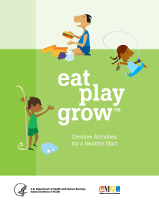EatPlayGrow™ Curriculum Guide
Welcome!
The EatPlayGrow™ curriculum offers engaging activities, essential facts, and simple strategies that make healthy choices fun and easy to include in daily routines—at home or at school!
In partnership with the National Institutes of Health (NIH), the Children’s Museum of Manhattan (CMOM) combined its existing arts and literacy-based early childhood education curriculum and family engagement program model with the NIH’s We Can! program into EatPlayGrow™ to create a series of 11 healthy lifestyles lessons for children age 6 and younger. The EatPlayGrow™ curriculum incorporates art-making, storytelling, music and movement activities into fun and hands-on educational lessons to teach young children and their adult caregivers about the importance of making positive choices in areas that most affect health: nutrition, physical activity and, based on the latest medical research, sleep.
Importance of Family Learning
A key National Health Standard for grades Pre-K to 2nd is the recognition that healthy habits start at home and that families play a crucial role in forming children’s healthy habits. By working, eating, and actively playing side-by-side, families can model, replicate, and extend the health activities found in the EatPlayGrow™ curriculum. The curriculum’s Parent Handouts and Family Health Journal are follow-up tools for families to help them discuss the lessons and assist parents as they employ information learned through the curriculum at home. Furthermore, doing these activities together, outside of a classroom setting, can deepen the bond between caregiver and child.
School and Day Care Settings
Schools and daycare facilities seek learning opportunities that are both interactive and engaging. EatPlayGrow™ lessons are designed to fit that goal with materials that are variable and flexible. This versatile curriculum can be incorporated into already existing programming or stand alone as its own health unit.
Lesson Structure
EatPlayGrow™ lessons all follow a similar structure and are designed to address the multiple ways children learn and help adult caregivers understand and support their child’s development.
Each lesson clearly defines the appropriate National Pre-K Health Performance Standards and Preschool Readiness Skills they meet. Keeping in mind that children learn at their own pace, teachers and parents can feel free to adjust the length of activities accordingly. All lesson plans have visual aids that can be used to support and reinforce the lesson themes.
Each lesson includes the following components:
Introduction/Discussion
Best practices for leading participants through introduction and discussion on the specific health lesson.
Key Teaching Messages
Top health messages that connect to art and literacy activities in each lesson.
Art Activity
Highlights how children can apply new health expertise in creative ways, the importance of being creative with art materials, and allows children to express themselves and make independent choices as they explore the process of creation rather than the finished product.
Healthy Snack
Provide snacks that encourage healthy eating habits, while introducing families to new foods. It is also important to
emphasize the importance of healthy hand washing practices to young children.
Group Storytime
Reading during each lesson is an important time for making further literacy connections to the health topic. As children hear stories, they learn new health vocabulary, and develop listening and reading readiness skills. They also build group participation skills and learn to be part of a group.
Physical Activity
It is important to get all participants moving and singing—habits we want to help develop from an early age! Look for
children to demonstrate physical control and coordination of muscle groups, and to follow a sequence of movements.
Parent Handout
All families receive a lesson specific parent handout that reinforces health messages and provides hands-on activities to extend the learning at home.
Families also receive a Family Health Journal that encourages self-reflection on each of the health lessons. This is included as an appendix to this document.
Have Fun!
Work to empower yourself and your community to learn and grow strong together!
| Back to Table of Contents | Back to Top |
NIH Publication No. 13-7818
April 2013











